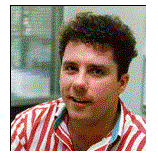Plasmonics:
Photonic Devices in Nanostructure Arrays
that Beat the Diffraction Limit
Harvard
- Gordon McKay Professor, Division of
Engineering and Applied Sciences
Caltech
- Howard
Hughes Professor and Professor of Applied Physics and Materials Science
(On Leave)
Atwater
Research Group
Background
Papers for Talk:
"Guiding Light" by
Harry Atwater. spie's oe magazine, July 2002.
"Plasmonics
- A Route to Nanoscale Optical
Devices" by Stefan
A. Maier, Mark
L. Brongersma, Pieter
G. Kik, Sheffer
Meltzer, Ari
A. G. Requicha, and
Harry A. Atwater.
Adv. Mater. 2001,
13, No. 19,
October 2
"Local
Detection Of Electromagnetic Energy Transport Below The Diffraction Limit
In Metal
Nanoparticle Plasmon Waveguides" by Stefan
A. Maier ,
Pieter G. Kik ,
Harry A. Atwater, Sheffer Meltzer
, Elad Harel, Bruce
E. Koel, and Ari A.G. Requicha. Accepted,
Nature Materials 2003
Since
development of the light microscope in the 16th
century, optical device size and performance has been limited by
diffraction. Optoelectronic devices of today are much bigger than
the smallest electronic devices for this reason. However the
diffraction limit can be circumvented via design of -plasmonic-
optoelectronic device components with spatial confinement of light
at dimensions less than 10% of the wavelength. Such plasmonic
devices exploit the dipole-dipole coupling at the plasmon frequency
between nanoscale metal particles in particle chain arrays, and the
dispersion relations for these structures indicate the tendency for
electromagnetic excitations to couple between electric dipoles rather than
radiate into free space. Light can also be propagated around sharp
corners and through nanoscale networks -- impossible in conventional
optical waveguides. Thus there appears to be no fundamental scaling
limit to the size and density of photonic devices, and ongoing work is
aimed identifying important device performance criteria in the
subwavelength size regime.
Ultimately
it may be possible to design a class of subwavelength-scale optoelectronic
components (waveguides, sources, detectors, modulators) that could form
the building blocks of an optical device technology that is scaleable to
molecular dimensions, with potential imaging, spectroscopy and
interconnection applications in computing, communication and
chemical/biological detection.
Harry
Atwater (Ph.D. )
Gordon McKay Professor of Applied Physics and Professor of Physics,
Harvard University.

Professor
Atwater's research interests center around fundamental and applied
research in synthesis, properties and processing of materials for use in
the electronic, photonic, and electro/opto/mechanical devices and circuits
of the 21st century. Current
major research efforts center on 1. multimaterial integration via layer
transfer of single-crystal piezoelectric and electrooptic oxides as well
as III-V compound semiconductors on silicon; 2. thin film photovoltaic
materials and devices, including thin film silicon and III-V compound
photovoltaic heterostructures 3. nanocrystal electronic and optoelectronic
devices, including silicon nanocrystal nonvolatile memories and
electrooptic devices, as well as subwavelength-scale photonic devices
based on plasmon energy localization in ordered arrays of metal
nanocrystals.
He has consulted extensively for industry and
government, and has actively served the materials community in various
capacities, including MRS Meeting Chair (1997), MRS President (2000), AVS
Electronic Materials and Processing Division Chair (1999), Gordon
Conference Chair (2001). Outside
the materials world, he enjoys coaching soccer teams for his sons, ages 8
and 5.
|